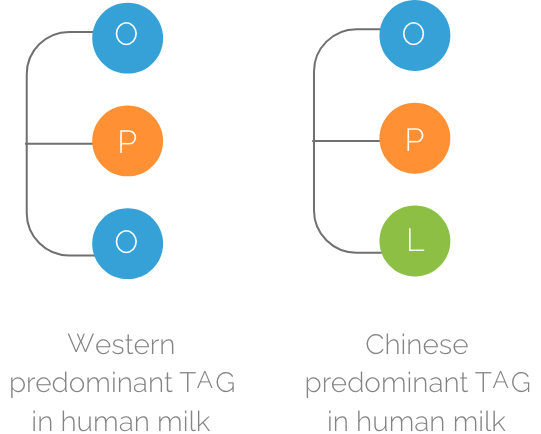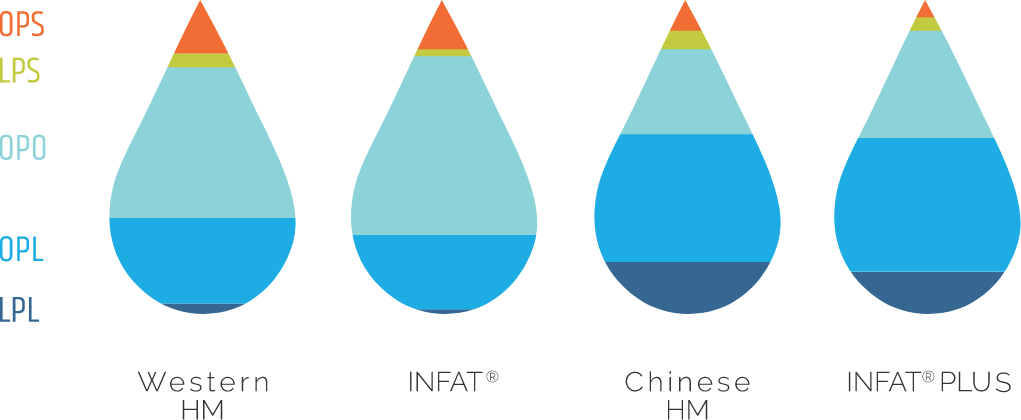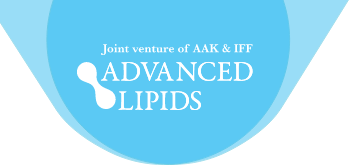
The best choice for Chinese infant formula
INFAT®PLUS, the innovative sn-2 palmitate fat blend developed by Advanced Lipids, was designed to be closer in structure to Chinese human milk fat and complies
with GB standard 30604-2015 for OPO.

OPO and OPL – the most abundant triglycerides (TG) in human milk fat
In human milk, palmitic acid (16:0) is the most abundant saturated fatty acid, while Oleic acid (18:1) is the major mono-unsaturated fatty acid. The palmitic acid is often bound to the glycerol mid-position (also known as sn-2 position). TGs with the structure Oleic-Palmitic-Oleic (OPO, 18:1-16:0-18:1) are among the major TG species found in human milk and represent an estimated ~14% of total TG species [1].
However, data collected from human milk studies in China suggests that in Chinese women, the major
TG species found is Oleic-Palmitic-Linoleic (OPL,
18:1-16:0-18:2) [2,3]. This contrasts with the TG profile in human milk collected in other places, such as Spain [4], Finland [5], or Denmark [1], where the level of OPO is higher than OPL.
The basis for this difference has not been fully evaluated yet but may be related to diet.
INFAT®PLUS – designed to be closer to Chinese human milk fat
In most infant formula produced today, the fat component is based on vegetable oils, where most of the palmitic acid is positioned on sn-1 or sn-3, and not on sn-2.
INFAT® is a specialty fat ingredient with palmitic acid bound to the sn-2 position developed for infant formula.
INFAT®PLUS is a unique offer not only enriched with sn-2 palmitate, but also with an OPL/OPO ratio which is closer to that found in Chinese human milk.
INFAT®PLUS is specifically designed to be closer to the TG structure found in Chinese human milk fat

Figure 2:
Typical profile of OPO and OPL, as well as all major TG species, as part of the C52 fraction of the TG in human milk from Western lactating mothers compared to Chinese lactating mothers [2-5].
References:
1) Zou, X., et al., ‘Lipid composition analysis of milk fats from
different mammalian species: potential for use as human milk fat substitutes’, Journal of Agricultural and Food Chemistry, 2013. 61(29): p. 7070-7080.
2) Sun, C., et al., ‘Evaluation of triacylglycerol composition in commercial infant formulas on the Chinese market: A comparative study based on fat source and stage’, Food Chemistry, 2018.
252: p. 154-162.
3) Tu, A., et al., ‘A comparative study of triacylglycerol composition in Chinese human milk within different lactation stages and imported infant formula by SFC coupled with Q-TOF-MS’, Food Chemistry, 2017. 221: p. 555-567.
4) Morera Pons, S., et al., ‘Triacylglycerol composition in colostrum, transitional and mature human milk’, European Journal of Clinical Nutrition, 2000. 54(12): p. 878-882.
5) Kallio, H., et al., ‘Triacylglycerol regioisomers in human milk resolved with an algorithmic novel electrospray ionization tandem mass spectrometry method’, Food Chemistry, 2017. 233: p. 351-360.
